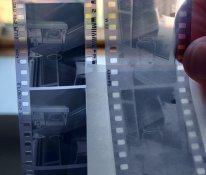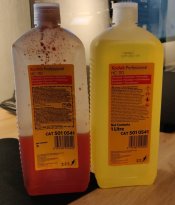- Joined
- Mar 31, 2014
- Messages
- 399
- Format
- 35mm
The manufacturer recommended times are just a starting point, there’s nothing wrong with developing longer if that gets you the negatives you want.
How was the the light(contrasty, flat) when you took the pictures? I deal with a lot of overcast days so usually end up developing for longer than the recommended time to get more contrast.
It’s mostly just personal preference however, provided I have sufficient shadow detail I can pretty much get the contrast I want when printing.
The light was mostly flat however in some shots there was a big difference between the darkest part and the highlights and yet they don't show up.
So you are relying on the settings in the firmware for the built-in image processor in your camera, which is making many, many choices for you that you have no control over, other than through the menus on the camera.
I understand that you prefer the "out of the box" results you obtain from denser negatives, but that doesn't mean that the denser negatives are better than less dense negatives - either for darkroom printing or digitizing.
I'm shooting RAW so yes it still gets processed a little but minimal.
About "that doesn't mean that the denser negatives are better than less dense negatives", then why does development time matter so much if you can just fix it in post? I think a denser negative scans better and looks better than a thin negative which is digitally made more contrasty.
Are you following the recommended agitation? Doing something different? https://imaging.kodakalaris.com/sites/uat/files/wysiwyg/pro/chemistry/j24.pdf. shows 30 second intervals for small tank manual agitation.
Are you sure your temperature is accurate? When it says 68 degrees, that's what it means, not 66 degrees, or almost 67 degrees, or 69 degrees. Have you done a test pour with an already developed roll of film and verified what the actual temperature in the tank is 1 minute after pouring in the liquid in? You'd be amazed at how much it changes, especially if the ambient air temperature isn't 68 degrees. Black and white isn't as finicky about temperature as color is, but it still matters enough that you want to be as close to the specified temperature as you reasonably can be. Also, make sure your thermometer is also accurate. You'd be amazed at how many aren't.
outside of that, yes, make sure you have fresh developer.
I do 1 minute intervals instead of 30 seconds. Does it matter that much?
So if I need to develop 5 minutes =
5 seconds agitation, 25 seconds nothing, 5 seconds agitation, 25 seconds nothing and repeat until 5 minutes?
Also, how long should the initial agitiation be after pouring in?
I have a new thermometer from Kaiser, so yes, I checked if the temp was 20C constant.
You have to adjust the contrast of the scans to taste. A simple scan and invert in PS will generally result in very flat negatives. Also, if using a camera, you're shooting raw right?
Yes I am shooting RAW. Yes a simple invert gives a flat negative indeed but if I scan denser negatives with my digital camera and do a simple invert, it's mostly just right in contrast.
How do you time 5 minutes? 1 minute error is a 20% error. If you choose a dilution that brings to 10 minute developing time, then a one minute error is only 10%
I prefer at least 8 minutes.
I use an RH Design Processmaster II timer for my timing. I was thinking of switching to dilution H.
Last edited:




 !
!

